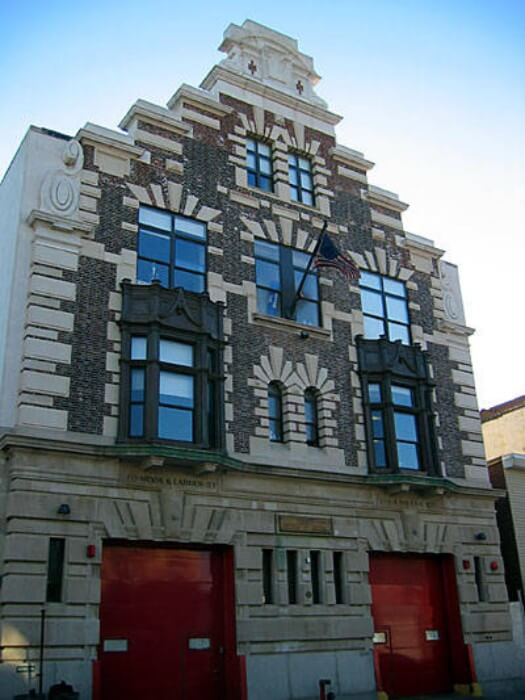
Queenswalk: The Firehouse in Hunter’s Point: Engine Co. 258 and Ladder Co. 115
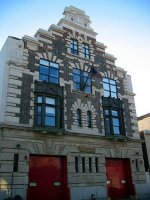
Photo via queens.about.com
Sep 11, 2013 • 11:00am
No matter what they look like, there is something very American about a firehouse; it makes even a cynic such as myself swell with civic pride. I grew up in the wilds of upstate New York, where the town fire company was all volunteers, and we knew most of the firemen who manned the house; they were my friends’ fathers and older brothers and uncles.
Fortunately, there were very few fires in my town, and our fire house was used more for social and fundraising events than for emergencies. Every Fourth of July, they sponsored the best BBQ fundraiser ever, and even though I haven’t been in town for that event in 40 years, I still remember the long lines of people patiently standing to get a paper plate full of potato salad, green salad with Italian dressing, a store-bought dinner roll, and the best upstate barbecued chicken in the known universe.
After college, when I moved to the North Bronx to stay with my grandmother and look for a job, I saw what professional firefighting was all about. It was the late 1970s, and the Bronx was literally burning, as landlords cut their losses, and tenants sick of living in horrible buildings seemed to conspire to lay waste to the southern part of the borough. I did not live near there, but we still saw the fire trucks racing by at regular intervals.
I don’t remember any of the firehouses in the Bronx, but when I moved to Brooklyn a few years later, it was a “wow” moment. My neighborhood of Bedford Stuyvesant had a beautiful fire house, on Madison Street, near Nostrand Avenue.
I began noticing some of the firehouses in Manhattan; the ones near my jobs, and some of the police stations as well, and it dawned on me that there was a time when this stuff mattered. Sometime in the 19th century, city fathers made the decision that the buildings that housed the organizations that were the everyday face of civic responsibility needed to be architecturally worthy of the city itself. So they hired some of the best architects in the city, spent the money, and had them build our great firehouses and police stations.
Well, that curiosity would eventually lead me to the position of reporting about some of these architectural treasures to you. And what a great and varied collection of buildings they are! Queens was the recipient of a fair share of them, and one of the best is the house for Engine Company 258 and Ladder Company 115.
Brooklyn and Manhattan had fire companies that were established long before Queens’ were. Long Island City, because it is so close to Manhattan and was the center of Queens’ government, was the first part of Queens to get a professional fire company. That was in 1891. By comparison, independent cities like Manhattan and Brooklyn had professional companies mandated by state charter in 1865.
Before 1890, the separate towns that made up LIC had 12 volunteer fire departments. When the law authorizing paid departments in Queens was passed that year, all of the volunteer departments were disbanded, and five new houses were built for the new companies. When the city consolidated in 1898, these companies were brought under the control of a central New York City fire department.
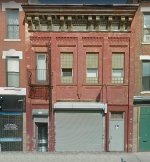
In 1899, the city announced that they were authorizing the building of new fire houses in Brooklyn and Queens. The fire house on Jackson Avenue that contained Engine 258 was considered one of the worst and most dangerous in the city, “a danger to life and limb,” according to the Brooklyn Eagle. The new fire house would be built on land purchased by the city at 10-40 47th Avenue, between Vernon Avenue and 11th Street.
The building was begun in 1902 and completed in 1904. It was built to accommodate Engine Co. 258, Ladder Co. 115, and headquarters for the battalion chief. It was close to the old fire house, but more importantly, close to Borough Hall and two important factories: the Pratt & Lambert Varnish Factory and an oil refinery for Standard Oil. The rest of the immediate neighborhood held schools, small businesses and a sizable residential area full of attached wood framed houses.
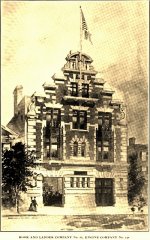
Over in Manhattan, the city had commissioned just one architect to design that city’s firehouses: Napoleon LeBrun. Between 1879 and 1894 he, and later with his sons, designed over 40 fire houses. Many still remain, and are gorgeous examples of civic architecture, and indeed worthy of Manhattan.
In Brooklyn, prior to 1898, that city had hired several of the best residential and commercial architects in that city to design firehouses. Peter J. Lauritzen, who designed my old Bedford Stuyvesant neighborhood’s firehouse on Madison Street was among them, as were the Parfitt Brothers, Frank Freeman, Frank J. Helmle and others. Their firehouses are also masterful and imaginative examples of fine civic architecture. Today, many of the fine fire houses of the LeBrun’s and the Brooklyn architects are protected by landmarking.
By 1900, the expanded Greater City of New York began hiring some new architects, and the most prominent of those was Ernest Flagg and Bradford Lee Gilbert. The two only designed three firehouses, but they were all masterful. Flagg’s were in Manhattan, and the architect of Engine Co. 258 was Bradford Lee Gilbert. A graduate of Yale University, he trained in the offices of Josiah C. Cady, a major talent who was the architect of the southern wing of the Museum of Natural History, as well as the old Metropolitan Opera House and the New York Presbyterian Hospital. Cady also designed 15 buildings on Yale’s campus, including the Peabody Museum, so no doubt that Yale connection was a plus.
In 1876, Gilbert was appointed architect for the New York, Lake Erie and Western Railroad. He designed buildings for them that can still be found throughout the eastern half of North America, including Detroit, Chicago, Ottawa and Halifax. He based his practice in Manhattan, and is credited as the architect of the first New York City skyscraper, the Tower Building, completed in 1899. It was located at 50 Broadway, and at eleven stories, was one of the first steel framed buildings in Manhattan. Gilbert was quite proud of this one, and maintained his office on the top floor of the building until his death in 1911.
Most of Gilbert’s designs were in the
Romanesque Revival style, but for the new firehouse, he decided to reference New York City’s Dutch roots. The step gabled roofline is a classic feature of Dutch building, dating back as far as the late 14th century. This feature was especially popular on canal houses and row houses, where small lots necessitated multi-story buildings. The step gables used on Engine 258 are called “proto-Baroque” by experts on Dutch building styles.
In any case, Gilbert was not the first to design Dutch Renaissance Revival firehouses. Napoleon LeBrun had designed one for the old Manhattan Engine Co. 15, now demolished. In Brooklyn, the Parfitt Brothers designed Engine Co. 253, which is in Bensonhurst, and landmarked. Both were before Gilberts’ Long Island City firehouse. Gilbert himself alter designed more than a few building in this style, suggesting he really liked it, as the buildings are as far flung as a train station in Mexico, a YMCA in Harlem, a hospital complex in Staten Island, and a group of row houses in Manhattan.
Engine Co. 258 and Ladder Co. 115’s new building opened with great fanfare, in 1904. It’s a magnificent building, quite visually striking and a prominent part of the streetscape. The top part of the roof is five stories tall, putting it at least a story above the rest of the block. His use of materials creates a powerful contrast between the light colored quoins, the key surrounds on the windows and the ornament, and the darker burnt brick.
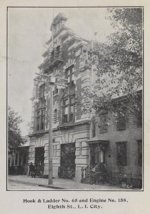
The building is 50 feet wide, built to accommodate both the engine and ladder trucks. The size of the building, and the bays themselves, predated our large fire trucks of today, but the building was built large enough to make housing them possible.
The tall structure could also accommodate hanging space for the hoses, which needed to be hung up lengthwise to dry properly when not in use. The firehouse also needed to have enough room to have a dormitory for the men, who at the time, worked 24-hour, six-day shifts before a day off. There were offices for the battalion commander, and the chief, as well as bathroom facilities, a day room and a kitchen/eating area.
Today, the firehouse is still in use, and a prominent landmark in the community. It’s been mentioned in every edition of the AIA Guide to New York City, and was called a “gem” in Jeffrey Kroessler and Nina S. Rappaport’s book
Historic Preservation in Queens. The building was also cited by the Queens Historical Society as a “Queensmark,” a building with architectural, historic or cultural significance.
It may also be recognized as the firehouse serving as the headquarters for the firefighters and EMTs in the television series
Third Watch, which aired from 1999-2005. The firehouse was landmarked in 2006.
Queens New York history: The story of firehouse Engine 258 on Jackson Avenue in Queens, New York.

www.brownstoner.com
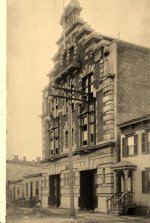
\





